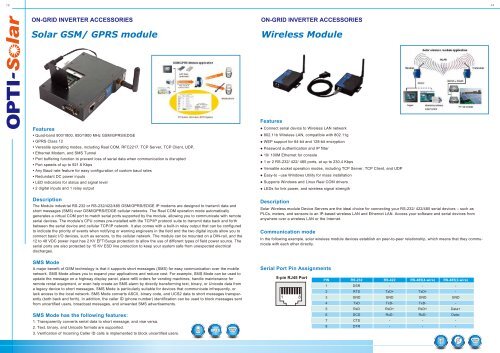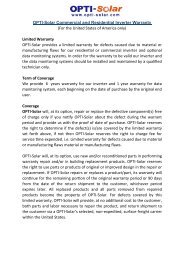Grid-Tied Photovoltaic System - OPTI-Solar
Grid-Tied Photovoltaic System - OPTI-Solar
Grid-Tied Photovoltaic System - OPTI-Solar
You also want an ePaper? Increase the reach of your titles
YUMPU automatically turns print PDFs into web optimized ePapers that Google loves.
13 14<br />
ON-GRID INVERTER ACCESSORIES<br />
<strong>Solar</strong> GSM/ GPRS module<br />
ON-GRID INVERTER ACCESSORIES<br />
Wireless Module<br />
Features<br />
• Quad-band 900/1800, 850/1900 MHz GSM/GPRS/EDGE<br />
• GPRS Class 12<br />
• Versatile operating modes, including Real COM, RFC2217, TCP Server, TCP Client, UDP,<br />
• Ethernet Modem, and SMS Tunnel<br />
• Port buffering function to prevent loss of serial data when communication is disrupted<br />
• Port speeds of up to 921.6 Kbps<br />
• Any Baud rate feature for easy configuration of custom baud rates<br />
• Redundant DC power inputs<br />
• LED indicators for status and signal level<br />
• 2 digital inputs and 1 relay output<br />
Description<br />
The Module industrial RS-232 or RS-232/422/485 GSM/GPRS/EDGE IP modems are designed to transmit data and<br />
short messages (SMS) over GSM/GPRS/EDGE cellular networks. The Real COM operation mode automatically<br />
generates a virtual COM port to match serial ports supported by the module, allowing you to communicate with remote<br />
serial devices. The module’s CPU comes pre-installed with the TCP/IP protocol suite to transmit data back and forth<br />
between the serial device and cellular TCP/IP network. It also comes with a built-in relay output that can be configured<br />
to indicate the priority of events when notifying or warning engineers in the field and the two digital inputs allow you to<br />
connect basic I/O devices, such as sensors, to the cellular network. The module can be mounted on a DIN-rail, and the<br />
12 to 48 VDC power input has 2 KV EFT/Surge protection to allow the use of different types of field power source. The<br />
serial ports are also protected by 15 KV ESD line protection to keep your system safe from unexpected electrical<br />
discharges.<br />
Features<br />
● Connect serial device to Wireless LAN network<br />
● 802.11b Wireless LAN, compatible with 802.11g<br />
● WEP support for 64-bit and 128-bit encryption<br />
● Password authentication and IP filter<br />
● 10/ 100M Ethernet for console<br />
● 1 or 2 RS-232/ 422/ 485 ports, at up to 230.4 Kbps<br />
● Versatile socket operation modes, including TCP Server, TCP Client, and UDP<br />
● Easy-to –use Windows Utility for mass installation<br />
● Supports Windows and Linux Real COM drivers<br />
● LEDs for link power, and wireless signal strength<br />
Description<br />
<strong>Solar</strong> Wireless module Device Servers are the ideal choice for connecting your RS-232/ 422/485 serial devices – such as<br />
PLCs, meters, and sensors-to an IP-based wireless LAN and Ethernet LAN. Access your software and serial devices from<br />
anywhere over a wireless LAN or the Internet.<br />
Communication mode<br />
In the following example, solar wireless module devices establish an peer-to-peer relationship, which means that they communicate<br />
with each other directly.<br />
SMS Mode<br />
A major benefit of GSM technology is that it supports short messages (SMS) for easy communication over the mobile<br />
network. SMS Mode allows you to expand your applications and reduce cost. For example, SMS Mode can be used to<br />
update the message on a highway display panel, place refill orders for vending machines, handle maintenance for<br />
remote rental equipment, or even help create an SMS alarm by directly transforming text, binary, or Unicode data from<br />
a legacy device to short messages. SMS Mode is particularly suitable for devices that communicate infrequently, or<br />
lack access to the local network. SMS Mode converts ASCII, binary code, and UCS2 data to short messages transparently<br />
(both back and forth). In addition, the caller ID (phone number) identification can be used to block messages sent<br />
from uncertified users, broadcast messages, and unwanted SMS advertisements.<br />
Serial Port Pin Assignments<br />
8-pin RJ45 Port<br />
PIN<br />
1<br />
2<br />
1 8<br />
3<br />
4<br />
5<br />
RS-232<br />
DSR<br />
RTS<br />
GND<br />
TxD<br />
RxD<br />
RS-422<br />
-<br />
TxD+<br />
GND<br />
TxD-<br />
RxD+<br />
RS-485(4-wire)<br />
-<br />
TxD+<br />
GND<br />
TxD-<br />
RxD+<br />
RS-485(2-wire)<br />
-<br />
-<br />
GND<br />
-<br />
Data+<br />
SMS Mode has the following features:<br />
1. Transparently converts serial data to short message, and vise versa.<br />
2. Text, binary, and Unicode formats are supported.<br />
3. Verification of Incoming Caller ID calls is implemented to block uncertified users.<br />
GPRS<br />
Quad-Band GPRS Class 12<br />
RS-232/422/485<br />
6<br />
7<br />
8<br />
DCD<br />
CTS<br />
DTR<br />
RxD-<br />
-<br />
-<br />
RxD-<br />
-<br />
-<br />
Data-<br />
-<br />
-<br />
Wireless<br />
Software<br />
Control<br />
RS-232/422/485

















